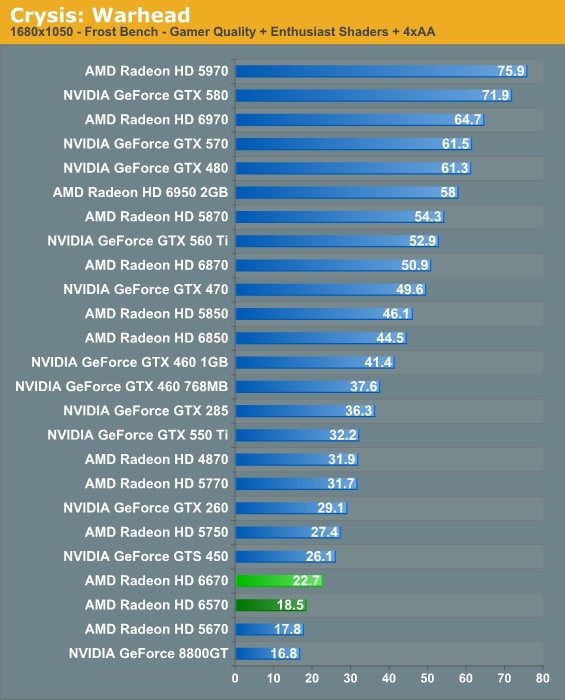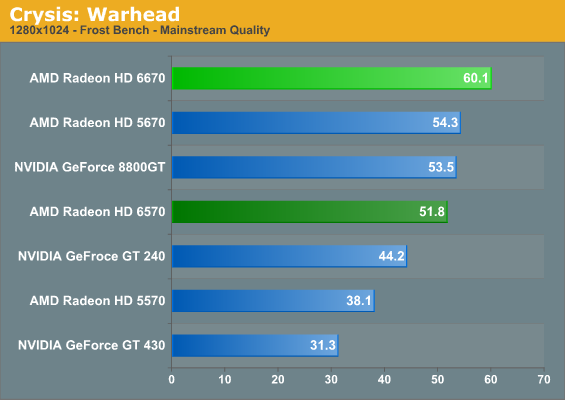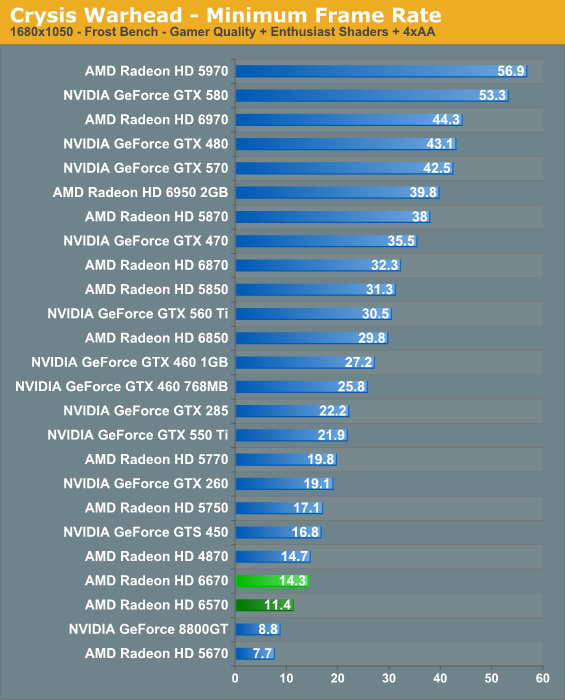AMD’s Radeon HD 6670 & Radeon HD 6570: Two’s Company, Sub-$100’s A Crowd
by Ryan Smith on April 19, 2011 12:01 AM ESTCrysis: Warhead
Kicking things off as always is Crysis: Warhead, still one of the toughest games in our benchmark suite. Even three years since the release of the original Crysis, “but can it run Crysis?” is still an important question, and for three years the answer was “no.” Dual-GPU halo cards can now play it at Enthusiast settings at high resolutions, but for low-end cards even Mainstream/Medium quality is about the best that can be achieved.


It takes a 5770 to crack 30fps in Crysis at 1680x1050, so the fact that the 6670 is only a bit over 20fps isn’t a big surprise. As far as performance at 1680 is concerned Crysis is a good summary of what we’ll see: too slow for 1680, and well behind the next tier of cards represented by the GTS 450 and the Radeon HD 5770/5750. However the 6670 does have a notable advantage here: with 1GB of VRAM it handles 1680 much better than the 512MB 5670, even if it’s ultimately too slow to be playable at these specific settings.
So for the kind of high settings we like to test at, it’s 1280 that’s going to be playable on the 6670, 6570, and similar cards. Once we drop down to 1280 and Mainstream quality the 6670 can crack 60fps, and with a bit of fiddling it should be possible to increase the quality of a setting or two without significantly impacting performance. Overall the 6670 has a 10% lead over the 5670 it replaces, which is a reasonable outcome for a game that’s largely (but not completely) shader-bound.
As for the 6570, it’s well-entrenched near the top of the pack. At 95% of the performance of the 5670 it does quite well, and the next-fastest modern card is the GT 240 which is quite some distance off. Against the 5570 it has a 35% lead, thanks largely to the use of GDDR5 instead of DDR3.
We have also thrown in the 8800GT into our 1280 results, just to offer a different look at performance relative to NVIDIA’s retired champion. It’s a good reference point for where we’re at now, versus what a $300 card did 3 years ago; and once we get to power/temperature/noise testing how better process technology and smaller GPUs have improved those metrics.


Looking at the minimum framerates, the relative ranking of our cards remains unchanged. The 6670 cements its lead over the 5670 here at 1680 thanks to its 1GB of VRAM, while at 1280 the gap narrows significantly to 5%. Meanwhile the 6570 loses ground on the 5670, with the 5670 taking a 10% lead.










53 Comments
View All Comments
Ryan Smith - Tuesday, April 19, 2011 - link
Yes, they do. So does the 6450, which is why I suspect 6450 is going to be the best HTPC card for most people.SteelCity1981 - Tuesday, April 19, 2011 - link
I got a 5670 and the 10% increase in performance isn't worth me spening an extra 100+ dollars on a 6670. See what AMD has in stores with the Radeon 7 series.tomoyo - Tuesday, April 19, 2011 - link
Yep, it's not for anyone with a current 5xxx. For me, I may go for this card because I want something low power for htpc + casual gaming, and it should be silence-able as well with the low idle power usage. Also hdmi will be nice with audio when connecting to tvs :)G-Man - Tuesday, April 19, 2011 - link
RyanAre there any plans to do articles where you "revisit" old conclusions and see if they still hold true? Like for Radeon 5670, it wasn't priced well at launch and suffered for it in the review, but after price cuts it's pretty much recommended everywhere in the price segment. It's often hard to understand exactly what Anandtech recommends at the moment, as opposed to at launch.
Thanks!
tomoyo - Tuesday, April 19, 2011 - link
Sounds like one of the only useful things from tomshardware, the video card price guide. I'd say you could always look there if you want to know the best current price/performance cards.789427 - Wednesday, April 20, 2011 - link
Ding, Ding...I enjoy both sites as both provide me with news and different perspectives but Mr Smith, kindly refrain from bad-mouthing your colleagues.
Let me provide you some insight that seems to refute Anandtech and Tomshardware *shared* claims about the latest and best in graphics...
Both sites focussed on noise as being the decision criteria for adopting one top end card over the other. Availability is more pertinent in the case of the high end cards.
To focus on noise as the deal-breaker seemed quite moot when Nvidia doesn't intend shipping 590 cards in volume.
Furthermore, a reference design at this level is simply a speed showcase - I don't for a second think that the majority of cards will be sold based on the reference design but at this level, manufacturers will listen to their client's desires (or to the noise the card actually makes and make some changes;))
In this particular instance, I was amazed at how much your opinions overlapped.
The reason that I've gone to such lengths with this particular example is to highlight what the most useful thing about Anandtech and Toms actually is - a difference of opinion that better highlights the truth often shaded by opinions and preconceptions.
Your comment above should seriously be reconsidered as I believe that as a genre, both sites have actually contributed to each other's success far more than any individual, including yourself, has.
My 2c.
Finally, about the cards... I find both fill a market. new purchasers of 1080 screen non-gamers will be satisfied with the lower offering and people that just want good performance without changing PSUs, heating a room and generally want good bang for the buck. How many people pay MSRP online? So the launch price tends to be higher... Just state the price that you'd recommend it and save us from reading the same old comments over again...
So, the 5750 is going to become an outmode as soon as the 7 series is out. and there are cards to replace it that are cheaper to make and run cooler. Not quite news but good to see in the flesh. Wasn't the real story of the 6 series that AMD finally got crossfire to scale right? ah well...
Soulkeeper - Tuesday, April 19, 2011 - link
I'd like to see the stats tables include the memory bandwidth so I don't have to calculate it myself each time I read one of these.thanks
AstroGuardian - Thursday, April 21, 2011 - link
+1Arnulf - Tuesday, April 19, 2011 - link
This not only goes to show how much hardware has improved over time but it also gives owners of older cards, perhaps with a rattling fan or some other issues, plenty of incentive to upgrade. My X1950Pro gave up on me recently so I went for Vapor-X version of HD5770. New card is virtually silent compared to that old beast.Keep up this practice and consider including comparable models from BOTH manufacturers ! :)
vavutsikarios - Tuesday, April 19, 2011 - link
There are 2 things I want to say, both a bit sideways the topic.First, about the paperlaunched 6450, I dont get it. The card is for sale, retail, at various shops here 2 weeks now. Doesnt look like a paperlaunch from where I stand, and this is not the most central part of the world (i live in greece)
Second, and more important, there is an upcoming game I d like to see in reviews. I am talking about might and magic heroes 6, scheduled to launch on June 23.
There is an interesting twist about it, most probably. I mean, if the game is anything like its predecessors, its going to be much more useful as a CPU than as a GPU benchmark. I mean, you can easily play a turn based strategy while on 15-20 fps. They are enough. But when I run the 6 years old heroes 5, with all the graphics details on high, no problem there, I still have to wait for the AI to complete their turn. The game is CPU limited SIX YEARS after it was released!!